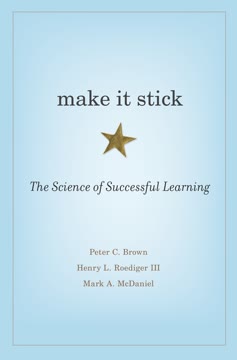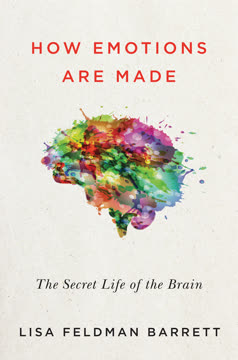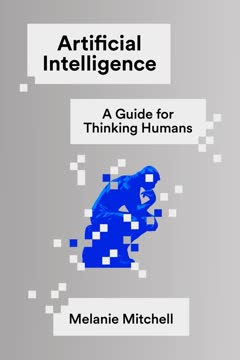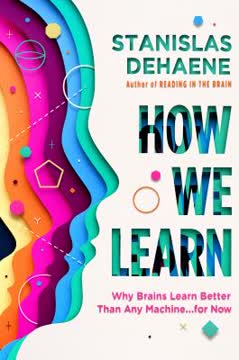Key Takeaways
1. The brain is born with innate knowledge, not a blank slate
No, babies are not blank slates: as early as the first year of life, they possess vast knowledge of objects, numbers, probabilities, space, and people.
Innate capabilities: Infants are born with sophisticated cognitive abilities, including:
- Object permanence: Understanding objects continue to exist when out of sight
- Number sense: Ability to distinguish between small quantities
- Probabilistic reasoning: Expectation of likely outcomes
- Social cognition: Recognition of faces and understanding of others' intentions
These innate capabilities form the foundation for future learning and development. Far from being empty vessels waiting to be filled, babies actively engage with their environment using these pre-existing mental frameworks. This innate knowledge allows infants to quickly make sense of the world around them and learn at an astonishing rate during early childhood.
2. Learning is an active process of hypothesis testing
To learn is to form an internal model of the external world.
Brain as scientist: The brain constantly generates hypotheses about the world and tests them against incoming sensory data. This process involves:
- Prediction: The brain makes predictions based on its current model
- Observation: It compares predictions with actual sensory input
- Error detection: Discrepancies between predictions and observations are noted
- Model updating: The internal model is adjusted to better fit reality
Learning occurs when there's a mismatch between prediction and reality, prompting the brain to update its model. This active, hypothesis-testing approach allows for efficient learning and adaptation to new environments. It explains why passive exposure alone is often insufficient for effective learning, and why engagement and active exploration are crucial.
3. Attention, engagement, error feedback, and consolidation are key pillars of learning
Attention, active engagement, error feedback, and consolidation are the secret ingredients of successful learning.
These four pillars form the foundation of effective learning:
-
Attention: Selectively focusing on relevant information
- Amplifies important signals
- Filters out distractions
-
Active engagement: Actively processing and manipulating information
- Generates hypotheses
- Tests predictions
-
Error feedback: Detecting and correcting mistakes
- Identifies gaps in knowledge
- Guides improvement
-
Consolidation: Stabilizing and integrating new knowledge
- Occurs primarily during sleep
- Strengthens neural connections
Educational strategies that incorporate these pillars are likely to be more effective than traditional passive learning approaches. Teachers and learners should strive to create environments and practices that leverage these fundamental learning mechanisms.
4. Sleep plays a crucial role in memory consolidation and learning
Every night brings back memories of the day.
Sleep's learning functions:
- Replay of daytime experiences: During sleep, the brain replays neural patterns associated with recent learning
- Memory transfer: Information is moved from short-term to long-term storage
- Synaptic pruning: Weak connections are eliminated while strong ones are reinforced
- Insight generation: Sleep can lead to new connections and problem-solving breakthroughs
The importance of sleep for learning cannot be overstated. It's not just a period of rest, but an active time when the brain processes and consolidates new information. This understanding has implications for both personal learning strategies and educational policies, suggesting the need for:
- Adequate sleep for students of all ages
- Reviewing important information before sleep to enhance retention
- Reconsidering early school start times, especially for adolescents
5. The brain recycles existing circuits for new skills like reading and math
To learn is to form an internal model of the external world.
Neuronal recycling: The brain adapts existing neural circuits to support new cultural inventions like reading and mathematics. This process involves:
- Repurposing visual recognition areas for letter and number identification
- Adapting spatial processing regions for mathematical thinking
- Linking these recycled areas with language circuits
This recycling hypothesis explains how humans can rapidly acquire complex cultural skills that didn't exist in our evolutionary past. It also suggests that learning is constrained by our brain's existing architecture. For example:
- The visual word form area, which recognizes written words, develops in a specific brain region that's well-connected to language areas
- Mathematical thinking recruits circuits originally used for spatial and quantity processing
Understanding neuronal recycling can inform educational approaches, suggesting ways to leverage innate capacities to teach new skills more effectively.
6. Early childhood is a critical period for brain plasticity and learning
The more time goes by, the less you remember what you learned.
Critical periods: The brain is especially malleable during early childhood, making it a crucial time for learning:
- Language acquisition: Children easily learn multiple languages before puberty
- Sensory processing: Visual and auditory systems are shaped by early experiences
- Social skills: Early interactions form the basis for social cognition
While learning continues throughout life, certain skills are more easily acquired during these critical periods. This understanding has important implications:
- Early intervention is crucial for children with developmental disorders
- Rich, stimulating environments in early childhood can have lifelong benefits
- Neglect or trauma during these periods can have long-lasting negative effects
However, it's important to note that the brain retains some plasticity throughout life, and effective learning strategies can help adults acquire new skills as well.
7. Education should be tailored to how the brain learns
Pedagogy is like medicine: an art, but one which is based—or should be based—on precise scientific knowledge.
Evidence-based education: Educational practices should be grounded in our understanding of how the brain learns. This includes:
- Leveraging innate knowledge: Building on children's existing mental frameworks
- Promoting active learning: Encouraging exploration and hypothesis testing
- Providing timely feedback: Helping learners correct errors quickly
- Ensuring adequate sleep: Recognizing its role in memory consolidation
Effective educational strategies might include:
- Interactive, hands-on learning experiences
- Regular, low-stakes testing to reinforce learning
- Spaced repetition of key concepts
- Tailoring instruction to individual learning progress
By aligning educational practices with the brain's natural learning mechanisms, we can create more effective and engaging learning experiences for students of all ages.
8. Social interaction and shared attention are vital for human learning
Homo sapiens is a social animal whose brain is endowed with circuits for "natural pedagogy" that are triggered as soon as we attend to what others are trying to teach us.
Social learning: Humans are uniquely adapted for learning from others:
- Shared attention: Infants naturally follow others' gaze and pointing
- Imitation: Children readily copy actions and behaviors they observe
- Cultural transmission: Complex knowledge is passed down through generations
This social aspect of learning is a key factor in human cognitive development and cultural evolution. It allows for:
- Rapid acquisition of language and social norms
- Accumulation and transmission of knowledge across generations
- Collaborative problem-solving and innovation
Educational approaches should leverage this social nature of learning by:
- Encouraging peer-to-peer learning and group discussions
- Utilizing teacher demonstrations and guided practice
- Creating opportunities for cultural and intergenerational learning
9. Curiosity and active exploration drive efficient learning
To learn is to eliminate.
Curiosity-driven learning: The brain is naturally motivated to seek out new information and experiences:
- Dopamine reward: Novel information activates the brain's reward circuits
- Optimal challenge: We're most curious about things that are neither too simple nor too complex
- Active exploration: Self-directed exploration leads to more effective learning than passive reception
This intrinsic drive for knowledge can be harnessed in educational settings by:
- Allowing students to pursue their interests
- Presenting information in ways that pique curiosity
- Creating environments that encourage exploration and discovery
- Posing intriguing questions or problems to spark inquiry
By tapping into learners' natural curiosity, educators can increase engagement and improve learning outcomes.
10. Error feedback, not punishment, is essential for improvement
Error is therefore the very condition of learning.
Productive errors: Mistakes are a crucial part of the learning process, not something to be avoided or punished:
- Error signals: Discrepancies between predictions and reality drive learning
- Specific feedback: Detailed information about errors helps learners improve
- Growth mindset: Viewing mistakes as opportunities for growth enhances resilience
Effective error feedback should:
- Be timely and specific
- Focus on the task, not the person
- Provide clear guidance for improvement
Educational practices should create safe environments where learners feel comfortable making and learning from mistakes. This approach can:
- Reduce anxiety associated with learning
- Encourage risk-taking and creativity
- Foster a love of learning and resilience in the face of challenges
11. Spacing out learning and testing oneself enhances retention
The more you test yourself, the better you remember what you have to learn.
Effective learning strategies:
- Spaced repetition: Reviewing information at increasing intervals improves long-term retention
- Retrieval practice: Actively recalling information strengthens memory more than passive review
- Interleaving: Mixing different topics or types of problems enhances learning and transfer
These evidence-based techniques leverage how the brain consolidates and retrieves memories:
- Spacing allows time for sleep-dependent memory consolidation
- Retrieval practice strengthens neural pathways associated with the information
- Interleaving helps the brain distinguish between similar concepts and apply knowledge flexibly
Practical applications include:
- Using flashcards with increasing intervals between reviews
- Regular low-stakes quizzing in educational settings
- Mixing different types of problems in homework and practice sessions
By aligning study practices with how the brain learns and remembers, we can significantly enhance the efficiency and effectiveness of learning.
Last updated:
FAQ
What's How We Learn about?
- Exploration of Learning Mechanisms: The book examines how the human brain processes information and adapts over time, contrasting human learning with machine learning.
- Neuroscience and Education: Stanislas Dehaene integrates neuroscience findings with educational practices to improve teaching methods.
- Four Pillars of Learning: It identifies attention, active engagement, error feedback, and consolidation as essential mechanisms for enhancing learning.
Why should I read How We Learn?
- Understanding Learning Processes: Gain insights into how learning occurs in the brain, which can improve personal and educational outcomes.
- Practical Applications: Offers advice for educators and parents on fostering effective learning environments.
- Scientific Basis: The book is grounded in recent scientific research, providing credible and enlightening content.
What are the key takeaways of How We Learn?
- Active Learning: Learning requires active engagement and curiosity, essential for forming strong neural connections.
- Attention's Role: Attention is crucial for amplifying relevant information and filtering distractions, enhancing educational practices.
- Neuroplasticity: The brain's ability to reorganize itself based on experiences is central to acquiring new skills and knowledge.
What are the best quotes from How We Learn and what do they mean?
- “If we don’t know how we learn, how on earth do we know how to teach?”: Highlights the importance of understanding learning processes to improve teaching methods.
- “Learning is the triumph of our species.”: Reflects the unique human capacity to learn and adapt, emphasizing its evolutionary significance.
- “Neurons that fire together, wire together.”: Describes synaptic plasticity, where simultaneous neuron activation strengthens connections, crucial for learning and memory.
What are the four pillars of learning mentioned in How We Learn?
- Attention: Focuses on relevant information while filtering distractions, essential for effective learning.
- Active Engagement: Involves active participation, fostering curiosity and deeper understanding.
- Error Feedback: Crucial for refining knowledge and correcting misconceptions through real-world experiences.
- Consolidation: Stabilizes and integrates new information into long-term memory, with sleep playing a vital role.
How does How We Learn explain the difference between human learning and machine learning?
- Contextual Learning: Human learning involves understanding abstract concepts, unlike machines that rely on surface-level data.
- Neuroplasticity vs. Fixed Algorithms: The human brain adapts and reorganizes based on experiences, while machines follow fixed algorithms.
- Probabilistic Reasoning: Humans make inferences and predictions with limited data, whereas machines need vast amounts of data.
What role does attention play in learning according to How We Learn?
- Amplification of Information: Acts as a spotlight, enhancing relevant information processing and memory retention.
- Selective Filtering: Filters out irrelevant stimuli, focusing on pertinent information.
- Impact on Neural Activity: Increases neuron firing rates, strengthening synaptic connections for lasting memories.
How does How We Learn address the concept of neuroplasticity?
- Foundation of Learning: Neuroplasticity allows the brain to reorganize itself in response to learning experiences.
- Synaptic Changes: Learning involves strengthening or weakening synaptic connections based on activity.
- Limits of Plasticity: While powerful, neuroplasticity diminishes with age, making early learning intervention critical.
What is the significance of error feedback in the learning process as described in How We Learn?
- Correction of Misconceptions: Allows learners to identify and correct mistakes, refining understanding.
- Motivation to Improve: Feedback on errors motivates persistence and skill improvement.
- Strengthening Neural Connections: Adjusts synaptic connections to align with correct information, crucial for retention.
How does How We Learn suggest we can optimize learning environments?
- Create Engaging Experiences: Foster curiosity and active engagement to enhance learning.
- Utilize Feedback Mechanisms: Incorporate constructive error feedback to help learners adjust understanding.
- Encourage Attention Management: Focus on strategies to manage attention effectively, reducing distractions.
How does How We Learn address the importance of sleep?
- Memory Consolidation: Sleep plays a crucial role in consolidating memories formed during the day.
- Optimal Learning: Adequate sleep enhances learning efficiency and retention.
- Sleep and Development: Essential for cognitive development, especially in children.
What educational strategies does How We Learn recommend?
- Structured Learning Environments: Advocates for curricula that guide students through progressively challenging material.
- Encouraging Curiosity: Foster curiosity to enhance engagement and exploration.
- Feedback Mechanisms: Implement effective feedback to help students learn from mistakes, promoting growth.
Review Summary
How We Learn explores the neuroscience of learning, comparing human and machine learning processes. Dehaene presents four pillars of learning: attention, active engagement, error feedback, and consolidation. The book debunks learning myths and offers evidence-based strategies for effective education. Readers appreciate its insights into brain function, child development, and practical applications for teaching and learning. While some found parts challenging, most reviewers praised the book's clarity and relevance for educators, parents, and lifelong learners. Many consider it a must-read for understanding how the brain acquires knowledge.
Similar Books










Download PDF
Download EPUB
.epub digital book format is ideal for reading ebooks on phones, tablets, and e-readers.




